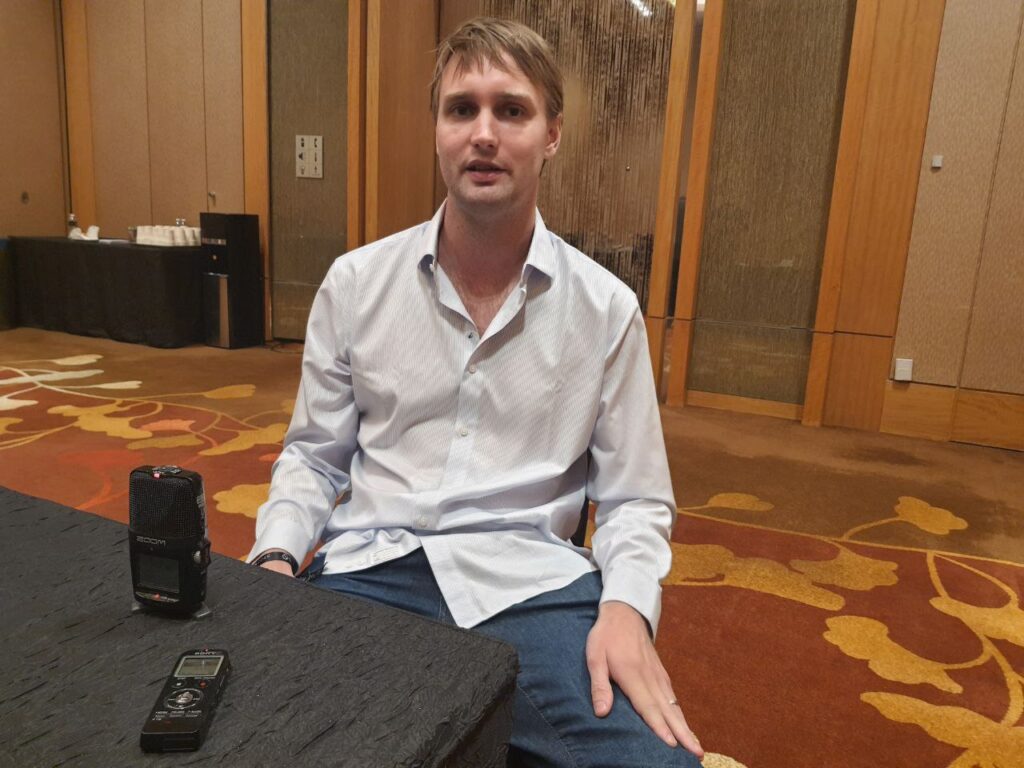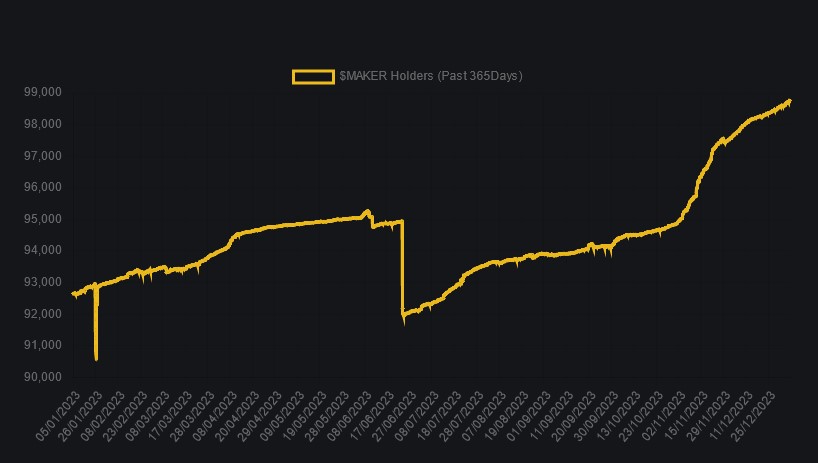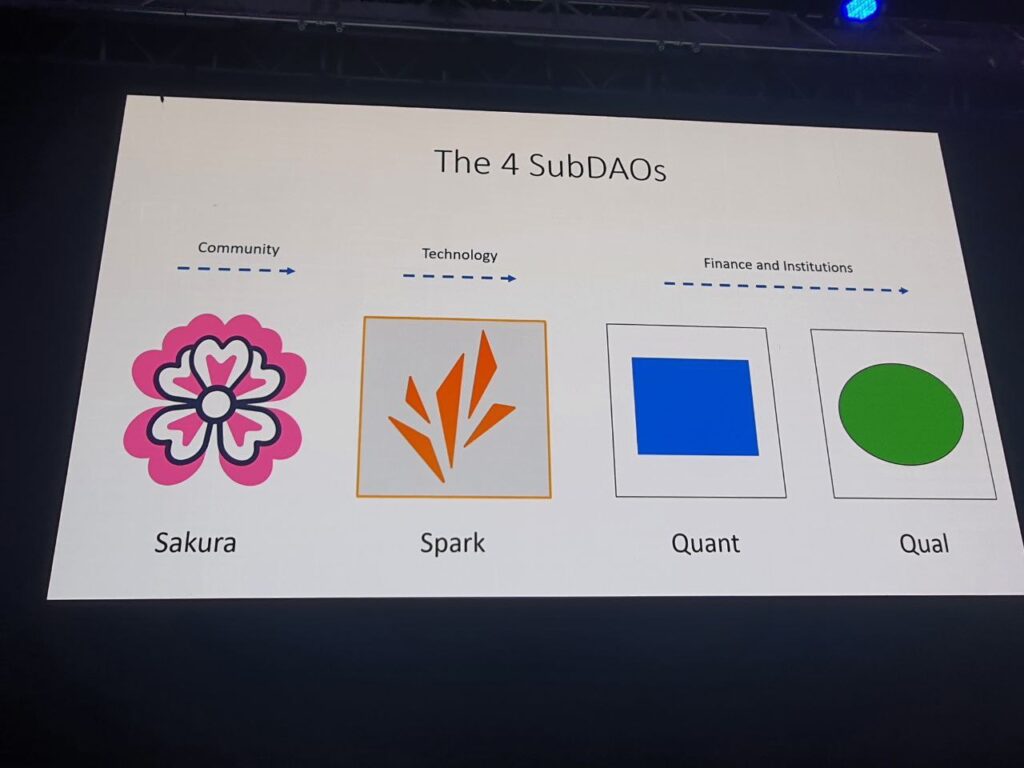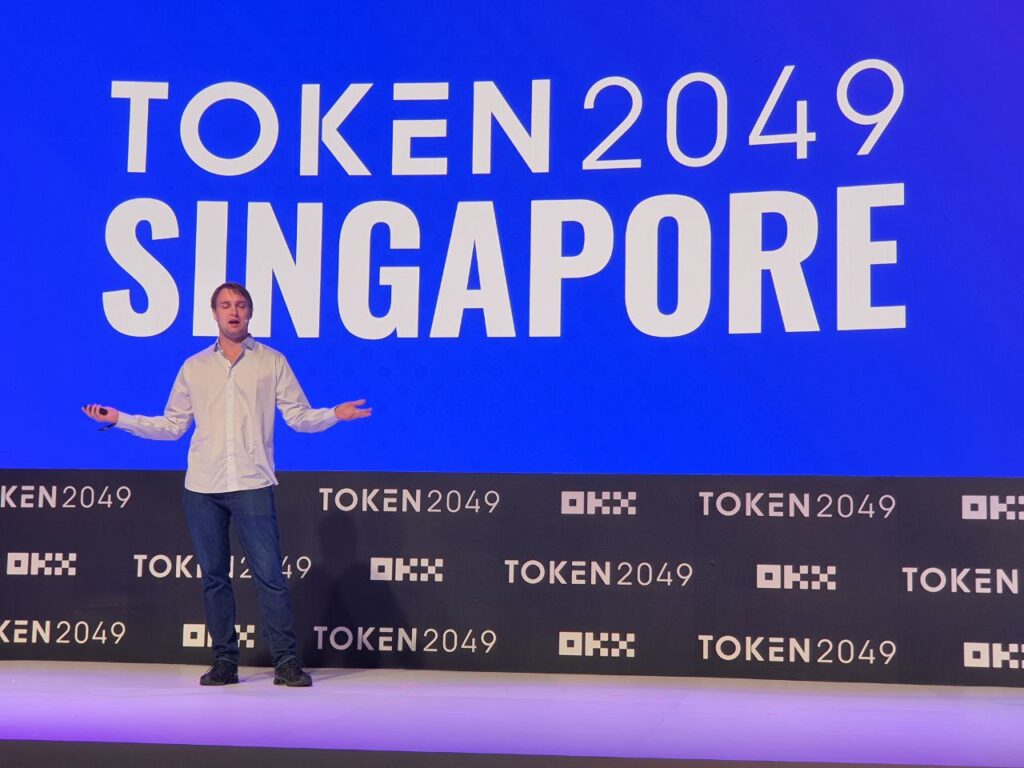During the last bull market, after a decade in the crypto space, MakerDAO founder Rune Christensen had grown disillusioned with the Ponzi schemes, degens and dog tokens.
“I thought it was over for the space at the top of the bull market. I was really convinced that crypto had nothing to offer because all I saw was games,” the tall, somewhat blandly good-looking Dane tells Magazine during an interview in Singapore.
“In Maker, we had something real, but we were incapable of organizing ourselves. And what happened was a bunch of politics, basically. Basically, I decided to give it one last shot.”
He had a good base to work from for his last roll of the dice. Backed by billions in U.S. Treasurys and on-chain assets, Maker is now raking in almost one-quarter of a billion dollars of revenue annually. Yet it has a price-to-earnings ratio of just 16, far below the Nasdaq average of 30.
There is a good reason Maker is so undervalued — it’s boring and complicated. Christensen set out to change all that by shepherding his controversial Endgame overhaul through the decentralized autonomous organization (DAO).
Endgame is nothing if not interesting. But it’s still extremely complicated, to the point that Reserve co-founder Nevin Freeman spent the first hour of a recent podcast trying to sum up Endgame before he even introduced his five-hour-long interview with Christensen.
What is Maker’s Endgame? Explain it like I’m five
TL;DR: It’s a five-phase plan that involves hiring an external marketing firm to rebrand the entire operation into something that seems cool and fun. Six new subDAOs will tilt at various windmills, attracting yield farmers and savers with the opportunity to nab millions of NewGovTokens and NewStables (placeholder names until the rebrand).
And, in an attempt to goose the price, they’re redenominating each Maker (MKR) token into 24,000 NewGovTokens.
Christensen sounds fired up and with a renewed sense of purpose talking about the plan.
“This time around, we finally realized that we simply can’t let all the scams and all the pump-and-dumps take the attention from the users because that’s just as irresponsible actually as building something that’s unsafe,” says Christensen.
“We want to bring back DeFi summer, but this time, it’s not going to end, and it’s not going to go to zero.”
Maker itself will operate like a central bank, setting monetary policy for the subDAOs. Expected to be established this quarter, each subDAO will hopefully be full of highly motivated tokenholders driven by a shared sense of purpose and given permission to risk the DAO’s very survival on high-conviction bets.
And if that’s not enough, MakerDAO will gradually transform itself into the first genuinely autonomous DAO using artificial intelligence.
This is another not-so-secret motivation behind Endgame; it’s a way for Christensen to finally leave the project — something he’s tried and failed to do on numerous occasions already. Each time, he’s drawn back in as things grind to a halt.

“Every single time I left, I was like, ‘I’m leaving,’ and then I have to go back, then I’m like, ‘I’m only coming back because now I’m going to solve the problem for good.’”
“In the early days, I thought, ‘We’ll just build the software that’s going to be an end.’ And then I realized, actually, the code isn’t even what matters — it’s the humans in Maker.”
He says the plan is an attempt to solve “what to do with the humans,” and it’s based on a decade’s worth of trial and error.
“I think it’s going to work this time. And in all cases, once it’s finalized, it simply will not be possible to change again. So, it has to work.”
‘We all hate Rune, we think this is ridiculous’
Unfortunately, the humans in Maker did not love Endgame, possibly because nobody apart from Christensen really understood his grandiose vision. Former Maker Foundation employee Greg Di Prisco told Wired in late 2022: “I didn’t vote, mainly because I find it incomprehensible.”
One Redditor implored MKR holders to save MakerDAO for “Rune’s egomaniacal plan” and criticized the plan to set up subDAOs, each with their own tokens, as “turning Maker into a ponzi-tokenomics factory.”
Vance Spencer, co-founder of Framework Ventures, thinks Christensen is a visionary but recalls the reaction to Endgame being pretty savage: “I mean, most people read it and just threw up on it,” he says. “But I think it was actually a pretty good synopsis of like, ‘what did we actually learn from the last cycle?’”
“There’s a lot in there that is: We need to align incentives; we need to spin out smaller groups that have a more narrow focus; we need to build out a central bank-commercial bank model; we need to redenominate; we need to rebrand like, there’s so much in there that’s important and interesting that I think just got lost in the ‘we all hate Rune, we think this is ridiculous.’”
Rune Christensen on why DAOs don’t work… yet
Although almost 100,000 addresses hold Maker and can theoretically vote on governance, in reality, all it took to get Endgame over the line was Christensen, a16z and two other delegate addresses. Among them, they had enough votes to force the plan through in October 2022. Ironically, the tokenomics of the new subDAOs are designed to avoid core team members and VCs having that sort of outsized voting power in the subDAOs in the future.
In fact, much of Endgame is a response to the very clear problems that Maker has had over the years with governance, which are the same issues holding back many other DAOs: greed, politics and nobody bothering to vote.
“We spearheaded everything, including those exact problems,” he says, explaining that when a project is small, everyone knows and trusts each other, but when it scales up, nobody knows one another.
“You can’t trust anyone anymore. Then suddenly, it becomes, ‘I don’t know if those guys over there are ripping me off or not. They might be ripping off the DAO; in fact, they probably are… so, I’m gonna make sure I’m also ripping off the DAO.’”

“So, everyone rationalizes this idea of ‘because the others are doing politics, I got to do politics.’ And then you start working and collaborating not with people who can contribute value, but it becomes a question of loyalty and political allegiance.”
Enter the SubDAOs: “The simple solution is just to chop it up into smaller pieces. So you always make sure that every single sort of unit of organization is small enough to keep the positive dynamic and not flip to that negative dynamic.”
There are two administrative SubDAOs called Zero and One, and four themed SubDAOs: Sakura (beginner-friendly DeFi and yield), Spark (technology-focused), Quantitative and Qualitative (real-world assets, finance and institutions).

A long time ago, on an island in Denmark
Born on a small island in Denmark, Christensen grew up in Copenhagen as a “very nerdy” kid who was really into World of Warcraft. After a stint teaching English in China during the global financial crisis, he studied international relations at Copenhagen Business School between 2011 and 2013, then moved on to biochemistry at the University of Copenhagen the following year.
In his first year of study, a Bitcoin donation address on a random website caught his eye, and he tumbled down the rabbit hole, buying as much as he could afford at $2 per BTC.
“Bitcoin totally radicalized me,” he says. “I mean, everyone’s looking for some meaning or purpose. And it hit right at the right time, right after the financial crisis when everyone was totally disillusioned with the old system.”
“I got really into that Bitcoin, culture and feeling of: We can use technology to fix the world.”
His first hint that there was more to blockchain than uncensorable hard money came when he got involved with a proto-Maker-style project called Bitshares, which was developing a decentralized exchange and a stablecoin. They were unable to deliver on their promise, though, so Christensen and a few others — including co-founder Nikolai Mushegian — set up Maker in 2014 to take advantage of smart contracts on the upcoming Ethereum network.
Sadly, Mushegian drowned in 2022, a few hours after sending out a paranoid tweet claiming the intelligence services were going to kill him. Some believe his death was a conspiracy; others believe he may have been suicidal, but the official cause of death is an accident. Whatever happened, he died way too young.
Christensen says Mushegian’s focus on technical security is one of the key reasons Maker has outlasted all of its competitors. He recalls that when smart contracts first emerged, many believed they were as immutable as the blockchain itself.
“We were just so lucky that my co-founder, Nikolai, he was sort of the person that realized things like smart contracts can get hacked.”
Maker delayed the launch of any products until they were bombproof, unlike The DAO, which jumped in early and was infamously hacked for $60 million. Playing it safe, however, contradicts crypto’s move fast and make lots of money ethos.
“The problem with that approach is you’re not going to, you know, attract tons of hype and get a lot of people rushing in, but you’ll outlast everyone else. So, that’s why we finally ended up on top.”
Maker attracted a bunch of crypto ideologues
In the early days, Maker was a loose coalition of naive ideologues tied together by the sense that crypto people “were just naturally superior humans… who assumed that if you added crypto to any system, then they will just overcome the flaws.”
Early governance was rudimentary at best. Each Sunday, there’d be a governance call that literally anyone could join, even if they didn’t own a token. The project was small enough that this slipshod approach worked, right up until Christensen decided it could run itself and left.
A power vacuum opened up; people started opposing every proposal, and the project ground to a halt. “Nothing happened, and nothing could be done,” he recalls. Belatedly, Christensen realized that, although Maker had been “roleplaying a DAO,” it was obvious that “in hindsight, I was the leader.”
“When we first ran into this thing of like, ‘Ideology isn’t enough, and being super naive just falls apart,’ we set up the foundation. We realized we just need a real organization to at least build and launch the thing.”
Established in 2017 and modeled on the Ethereum Foundation, the Maker Foundation became the guiding light of coordination that finally achieved real progress.
“We were able to ship, at the time, by far the most advanced smart contract system ever made,” he says proudly.
Dai, a stablecoin using ETH as collateral, launched in December 2017, just in time for the crypto winter, which saw ETH’s value plunge 80%. The decentralized stablecoin’s ability to weather the storm without collapsing highlighted its worth, and multi-collateral Dai launched two years later in December 2019.
It has to be said that Dai is not perfect. An S&P Global report found that between June 2021 and June 2023, it had spent more than 2,750 minutes off its $1 peg, falling below $0.90 for 20 minutes at one point.
There have been a bunch of missteps and controversies along the way, like the decision to add centralized stablecoin USD Coin as collateral, although this has largely been overtaken by U.S. Treasurys.
Christensen also courted controversy by proposing Solana (rather than Ethereum) be forked for Maker’s new blockchain called NewChain, which is part of the fifth and final phase of Endgame.
Although the launch of savings and borrowings platform Spark Protocol in May last year (which offers a 5% yield for Dai deposits) achieved rapid growth, the decision to cut off U.S. and VPN users for regulatory reasons caused outrage among crypto purists.
Spencer says Christensen has demonstrated an ability to roll with the punches.
“I think Rune is lucky to have learned from his mistakes — most mistakes and crypto just kill you; you’re not given the benefit of learning from them.”
Third version of Dai coming soon
The third version of Dai (NewStable) is outlined in Endgame, with MakerDAO as the central bank in effect licensing the subDAOs to create money.
“Instead of being a single mechanism for lending, it’s sort of spread across these subDAOs. So, they can each figure out their own approach to how they want to allocate and how they want to lend. So, it becomes just infinitely flexible and programmable.”
Maker has the power to create new governance tokens for the subDAOs and sell them. So, if a DAO gets into financial trouble, Maker can either raise money with the new tokens or get an indication from the market that the subDAO is likely toast. At that point, it can seize the subDAO’s assets and sell them.
He explains that the benefit of this setup is that the smaller teams will be risking their own governance tokens on their own projects.
“Let’s be willing to take some crazy risks and be willing to fail because sometimes it’s going to lead to some really amazing results,” he says.
“They’ve got each other’s back… They’re all gonna get screwed over if it goes wrong. So, they’re not gonna be about loyalty and politics. They’re gonna be about ‘We’ve got to do something that’s going to unleash the potential of blockchain.’”
“And then you have this evolutionary ecosystem where you actually allow things to do some crazy experiments.”
AI overlords to take over
Longer term, the idea is for the DAO to become self-sustaining and governed by AI according to its carefully crafted rule book called the Atlas, which Christensen has said could stretch to 13,000 pages.

The team is in the process of codifying all of the knowledge about the project, along with its rules and procedures, into a format that’s easily digestible by an AI so DAO members can consult it to find out what the hell is going on.
At present, few people outside the core team have an understanding of all the moving parts.
“A key tool is the sort of central mechanism for storing and validating all the data in a system — all the rules, all interactions — we call the Atlas. So, the Atlas is sort of the single source of truth for the DAO.”
“Having that sort of central repository of data just makes it mean it makes it actually realistic to have hundreds of thousands of people from different backgrounds and different levels of understanding actually meaningfully collaborate and interact.”
At the core of the Atlas is a kind of permanent constitution of “immutable documents” designed to protect the AI governance from bad actors or just from going off mission.
As the technology becomes more reliable, it will be given more responsibilities until eventually it’s running everything, and Christensen can happily retire, knowing Maker has become a perpetual motion machine.
“Those four will be the only subDAOS for the first couple of years,” he says. “And then, when we reach the final state of the system, it will begin to algorithmically — fully automatically with no human intervention — just generate new sub DAOs.”
“It’s possible that once you really get AI-assisted governance to sort of a level of maturity, you may have a lot more DAOs than you have humans, basically, because the cost of creating tokens and wrapping the governance function of a token around any particular economic interaction or business model is so low that if it works, then there’s no reason not to do it.”
week.

The post MakerDAO’s plan to bring back ‘DeFi summer’ — Rune Christensen appeared first on Cointelegraph Magazine.


